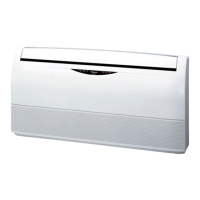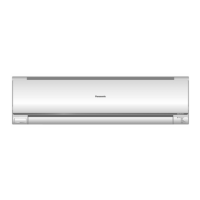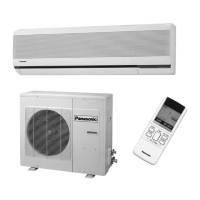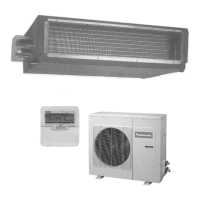Do you have a question about the Panasonic CS-A125KE and is the answer not in the manual?
Details the energy-saving and performance enhancement features of the air conditioner.
Covers features enhancing user comfort like sleep mode and air purification.
Summarizes improvements in quality, service, and operation for better user experience.
Highlights the filters' role in removing odors, dust, and improving air quality.
Covers compact design, remote features, and installation flexibility like long piping.
Details the functions and buttons of the remote control for unit operation.
Covers selecting modes (Auto, Cool, Heat, Dry), fan speed, airflow, power/economy modes, timers, and clock.
Explains sleep mode, auto-restart, and temperature setting adjustments.
Explains the automatic start button, operation lamps, and mode indications.
Details powerful, economy, auto-restart, anti-freezing, and sleep mode operations.
Describes indoor fan speed settings and airflow direction adjustments.
Covers time delay, safety controls, hot-start, and anti-cold draft features.
Details controls for compressor reverse rotation, overload, and fan operation protection.
Explains deicing mechanisms and overload protection for outdoor components.
Covers compressor protection logic and the function of the 4-way valve.
Provides front, side, and back views with detailed measurements.
Shows the size and layout of the remote control transmitter.
Details the relative positioning of the indoor unit and its mounting plate.
Lists remarks for wire colors used in the diagram.
Provides resistance values for indoor and outdoor fan motor windings.
Lists the resistance values for the compressor windings.
Explains the sequence and controls for the unit's cooling mode.
Details mechanisms to protect the compressor from damage during operation.
Describes how fan speed adjusts automatically during cooling operation.
Illustrates the timing of operations during cooling mode.
Explains the functions and controls for the soft dry (dehumidification) mode.
Illustrates the timing of operations during soft dry mode.
Details the functions and controls for the unit's heating mode.
Explains how the unit delays fan start until the heat exchanger warms up.
Describes how the unit prevents cold air drafts during heating.
Describes fan speed adjustments based on temperature during heating.
Illustrates the timing of operations during heating mode.
Explains the process to prevent outdoor heat exchanger frosting during heating.
Shows the timing sequence for normal deicing operations.
Illustrates the timing for deicing triggered by overload conditions.
Details how the unit automatically selects the operating mode based on conditions.
Explains the automatic adjustment for comfortable sleeping conditions.
Describes the random delay restart feature after power failure.
Details the function of the timer that starts operation before the set time.
Explains the beep sounds for remote control operations and how to disable them.
Details manual and automatic fan speed adjustments and random low speed.
Explains vertical and horizontal airflow adjustments for cooling, heating, and soft dry modes.
Details how to use economy mode for reduced power consumption.
Explains how to use powerful mode for quick temperature attainment.
General safety guidelines to prevent injury and property damage during operation.
Specific safety warnings and mandatory actions related to unit installation.
Safety warnings and mandatory actions for operating the unit safely.
Identifies the parts of the indoor unit, including vents, indicators, and filters.
Shows how to open the front panel and access internal components like filters.
Identifies the parts of the outdoor unit, including vents, piping, and terminals.
Lists the accessories provided with the air conditioner unit.
Details the buttons and display of the remote control, including cover-opened view.
Provides instructions on how to use the remote control effectively, including distance and aiming.
Shows how to open the back cover of the remote control for reset or access.
Steps to prepare the indoor unit before initial operation, including plug insertion and filter installation.
Important notes on electricity usage and recommended operating conditions.
Guides on how to insert batteries into the remote control correctly.
Step-by-step instructions for setting the current time on the remote control.
Advice on battery usage, replacement, and storage.
Explains how to select modes like Auto, Cooling, Soft Dry, and Fan.
Provides specific details on cooling and auto operation, including temperature settings.
Guides on adjusting fan speed and vertical/horizontal airflow direction.
Explains defrosting and automatic airflow adjustments during heating.
Step-by-step instructions for setting ON and OFF timers using the remote.
How to cancel timers and details on timer operation timing.
Examples of timer usage for sleep, waking up, going out, and returning.
Important notes regarding timer display and the TIMER LED indication.
Explains how to activate and operate the sleep mode for comfortable night-time use.
Details the operation and effects of Economy and Powerful modes.
Summarizes temperature and airflow changes for Economy and Powerful modes.
Instructions for gently cleaning the indoor unit and remote control.
Step-by-step guide for removing, cleaning, and reinstalling air filters.
Procedures for safely removing, cleaning, and reattaching the front panel.
Guidance on when and how to replace air purifying filters for optimal performance.
Step-by-step instructions for removing and reinstalling the air purifying filters.
Checks to perform before initial use, like air discharge temperature and obstructions.
Steps for preparing the unit for extended periods of non-use, including drying and power disconnection.
Advice on regular inspections to maintain performance and prevent issues.
Addresses common normal operation sounds and visual phenomena.
Explains why heating operation might stop temporarily or fan behavior.
Discusses occasional fan stops during auto fan settings.
Lists symptoms of abnormal operation like no operation or loud noise.
Identifies critical conditions requiring immediate dealer contact.
Explains how to use the auto operation button for automatic mode activation.
Covers auto restart after power failure and timer settings after power issues.
Details the unit's surge protection and advice for strong lightning.
Crucial warnings regarding appliance safety, servicing, and environment.
Important cautions for safe usage, especially when the unit is not in use.
Details on wire color coding and terminal connections for safety.
Lists all necessary tools for the installation process.
Emphasizes critical safety measures and warnings for installation.
Specific cautions related to grounding, flammable gas, and drainage.
Important considerations for installation location, power connection, and refrigerant handling.
Lists included accessories and specifies applicable piping kits.
Provides guidelines for selecting the best locations for indoor and outdoor units.
Detailed steps for mounting the indoor unit, drilling holes, and installing piping sleeves.
Steps for routing and insulating pipes when using embedded piping.
Procedures for inserting cables, managing covers, and connecting hoses.
Steps to connect indoor unit cables, including wire color checks.
Guidance on using piping bands and installing air purifying filters.
Covers selecting outdoor location, mounting, and connecting piping to outdoor unit.
Instructions for cutting, flaring, and checking copper pipes for leakage.
Procedures for evacuating the system and insulating pipes to prevent water formation.
Advice on draining outdoor unit water, especially in freezing conditions.
Steps for checking drainage and evaluating unit performance after installation.
Details the shaft positions and operations for the 2-way valve.
Details the shaft positions and service port operations for the 3-way valve.
Steps to access and remove the indoor electronic controller and related components.
Procedures for removing the indoor fan motor and its components.
Steps for removing the cross-flow fan assembly from the indoor unit.
Detailed steps for removing the cross-flow fan and associated parts.
How to reset the remote control if it malfunctions after battery changes.
Method for changing transmission codes to prevent interference with multiple units.
Guide to diagnosing malfunctions based on refrigeration cycle parameters.
How refrigerant levels affect pressure and electric current.
Methods to diagnose faults in the compressor and 4-way valve.
Graphs showing thermostat setpoints versus intake air temperature for different modes.
Tables detailing cooling and heating capacities based on various temperature conditions.
Performance curves for cooling and heating, and impact of piping length.
Performance curves for cooling and heating, and impact of piping length.
Performance curves for cooling and heating, and impact of piping length.
The first part of the main electronic circuit diagram.
The second part of the main electronic circuit diagram.
The third part of the main electronic circuit diagram.
Instructions for taking voltage measurements using a digital tester.
A table detailing timer operations and their test mode durations.
Shows the physical layout of components on the top side of the indoor unit's PCB.
Shows the physical layout of components on the bottom side of the indoor unit's PCB.
Details the energy-saving and performance enhancement features of the air conditioner.
Covers features enhancing user comfort like sleep mode and air purification.
Summarizes improvements in quality, service, and operation for better user experience.
Highlights the filters' role in removing odors, dust, and improving air quality.
Covers compact design, remote features, and installation flexibility like long piping.
Details the functions and buttons of the remote control for unit operation.
Covers selecting modes (Auto, Cool, Heat, Dry), fan speed, airflow, power/economy modes, timers, and clock.
Explains sleep mode, auto-restart, and temperature setting adjustments.
Explains the automatic start button, operation lamps, and mode indications.
Details powerful, economy, auto-restart, anti-freezing, and sleep mode operations.
Describes indoor fan speed settings and airflow direction adjustments.
Covers time delay, safety controls, hot-start, and anti-cold draft features.
Details controls for compressor reverse rotation, overload, and fan operation protection.
Explains deicing mechanisms and overload protection for outdoor components.
Covers compressor protection logic and the function of the 4-way valve.
Provides front, side, and back views with detailed measurements.
Shows the size and layout of the remote control transmitter.
Details the relative positioning of the indoor unit and its mounting plate.
Lists remarks for wire colors used in the diagram.
Provides resistance values for indoor and outdoor fan motor windings.
Lists the resistance values for the compressor windings.
Explains the sequence and controls for the unit's cooling mode.
Details mechanisms to protect the compressor from damage during operation.
Describes how fan speed adjusts automatically during cooling operation.
Illustrates the timing of operations during cooling mode.
Explains the functions and controls for the soft dry (dehumidification) mode.
Illustrates the timing of operations during soft dry mode.
Details the functions and controls for the unit's heating mode.
Explains how the unit delays fan start until the heat exchanger warms up.
Describes how the unit prevents cold air drafts during heating.
Describes fan speed adjustments based on temperature during heating.
Illustrates the timing of operations during heating mode.
Explains the process to prevent outdoor heat exchanger frosting during heating.
Shows the timing sequence for normal deicing operations.
Illustrates the timing for deicing triggered by overload conditions.
Details how the unit automatically selects the operating mode based on conditions.
Explains the automatic adjustment for comfortable sleeping conditions.
Describes the random delay restart feature after power failure.
Details the function of the timer that starts operation before the set time.
Explains the beep sounds for remote control operations and how to disable them.
Details manual and automatic fan speed adjustments and random low speed.
Explains vertical and horizontal airflow adjustments for cooling, heating, and soft dry modes.
Details how to use economy mode for reduced power consumption.
Explains how to use powerful mode for quick temperature attainment.
General safety guidelines to prevent injury and property damage during operation.
Specific safety warnings and mandatory actions related to unit installation.
Safety warnings and mandatory actions for operating the unit safely.
Identifies the parts of the indoor unit, including vents, indicators, and filters.
Shows how to open the front panel and access internal components like filters.
Identifies the parts of the outdoor unit, including vents, piping, and terminals.
Lists the accessories provided with the air conditioner unit.
Details the buttons and display of the remote control, including cover-opened view.
Provides instructions on how to use the remote control effectively, including distance and aiming.
Shows how to open the back cover of the remote control for reset or access.
Steps to prepare the indoor unit before initial operation, including plug insertion and filter installation.
Important notes on electricity usage and recommended operating conditions.
Guides on how to insert batteries into the remote control correctly.
Step-by-step instructions for setting the current time on the remote control.
Advice on battery usage, replacement, and storage.
Explains how to select modes like Auto, Cooling, Soft Dry, and Fan.
Provides specific details on cooling and auto operation, including temperature settings.
Guides on adjusting fan speed and vertical/horizontal airflow direction.
Explains defrosting and automatic airflow adjustments during heating.
Step-by-step instructions for setting ON and OFF timers using the remote.
How to cancel timers and details on timer operation timing.
Examples of timer usage for sleep, waking up, going out, and returning.
Important notes regarding timer display and the TIMER LED indication.
Explains how to activate and operate the sleep mode for comfortable night-time use.
Details the operation and effects of Economy and Powerful modes.
Summarizes temperature and airflow changes for Economy and Powerful modes.
Instructions for gently cleaning the indoor unit and remote control.
Step-by-step guide for removing, cleaning, and reinstalling air filters.
Procedures for safely removing, cleaning, and reattaching the front panel.
Guidance on when and how to replace air purifying filters for optimal performance.
Step-by-step instructions for removing and reinstalling the air purifying filters.
Checks to perform before initial use, like air discharge temperature and obstructions.
Steps for preparing the unit for extended periods of non-use, including drying and power disconnection.
Advice on regular inspections to maintain performance and prevent issues.
Addresses common normal operation sounds and visual phenomena.
Explains why heating operation might stop temporarily or fan behavior.
Discusses occasional fan stops during auto fan settings.
Lists symptoms of abnormal operation like no operation or loud noise.
Identifies critical conditions requiring immediate dealer contact.
Explains how to use the auto operation button for automatic mode activation.
Covers auto restart after power failure and timer settings after power issues.
Details the unit's surge protection and advice for strong lightning.
Crucial warnings regarding appliance safety, servicing, and environment.
Important cautions for safe usage, especially when the unit is not in use.
Details on wire color coding and terminal connections for safety.
Lists all necessary tools for the installation process.
Emphasizes critical safety measures and warnings for installation.
Specific cautions related to grounding, flammable gas, and drainage.
Important considerations for installation location, power connection, and refrigerant handling.
Lists included accessories and specifies applicable piping kits.
Provides guidelines for selecting the best locations for indoor and outdoor units.
Detailed steps for mounting the indoor unit, drilling holes, and installing piping sleeves.
Steps for routing and insulating pipes when using embedded piping.
Procedures for inserting cables, managing covers, and connecting hoses.
Steps to connect indoor unit cables, including wire color checks.
Guidance on using piping bands and installing air purifying filters.
Covers selecting outdoor location, mounting, and connecting piping to outdoor unit.
Instructions for cutting, flaring, and checking copper pipes for leakage.
Procedures for evacuating the system and insulating pipes to prevent water formation.
Advice on draining outdoor unit water, especially in freezing conditions.
Steps for checking drainage and evaluating unit performance after installation.
Details the shaft positions and operations for the 2-way valve.
Details the shaft positions and service port operations for the 3-way valve.
Steps to access and remove the indoor electronic controller and related components.
Procedures for removing the indoor fan motor and its components.
Steps for removing the cross-flow fan assembly from the indoor unit.
Detailed steps for removing the cross-flow fan and associated parts.
How to reset the remote control if it malfunctions after battery changes.
Method for changing transmission codes to prevent interference with multiple units.
Guide to diagnosing malfunctions based on refrigeration cycle parameters.
How refrigerant levels affect pressure and electric current.
Methods to diagnose faults in the compressor and 4-way valve.
Graphs showing thermostat setpoints versus intake air temperature for different modes.
Tables detailing cooling and heating capacities based on various temperature conditions.
Performance curves for cooling and heating, and impact of piping length.
Performance curves for cooling and heating, and impact of piping length.
Performance curves for cooling and heating, and impact of piping length.
The first part of the main electronic circuit diagram.
The second part of the main electronic circuit diagram.
The third part of the main electronic circuit diagram.
Instructions for taking voltage measurements using a digital tester.
A table detailing timer operations and their test mode durations.
Shows the physical layout of components on the top side of the indoor unit's PCB.
Shows the physical layout of components on the bottom side of the indoor unit's PCB.
| Indoor Unit Weight | 9 kg |
|---|---|
| Outdoor Unit Weight | 30 kg |
| Power Supply | 220-240 V, 50 Hz |
| Type | Split System |
| Outdoor Unit Dimensions (W x H x D) | 780 x 540 x 259 mm |












